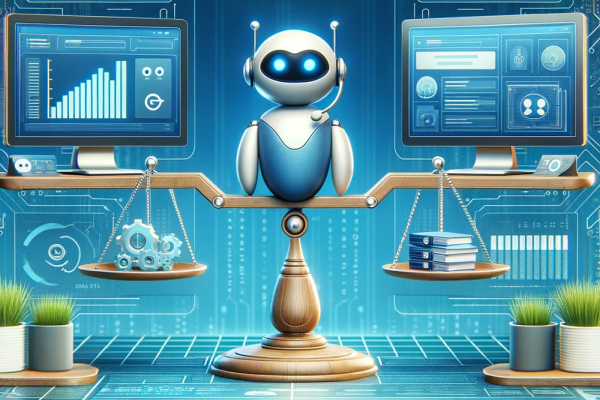AI in customer support is transforming businesses by saving costs, improving efficiency, and enhancing customer satisfaction. Companies are seeing measurable outcomes like $1.1M in savings, 248% ROI, and faster resolution times. Here’s what you need to know:
- Cost Savings: Automates routine tasks, reduces staffing needs, and provides 24/7 support.
- Performance Metrics: Faster issue resolution, higher customer satisfaction, and better one-contact resolution rates.
- ROI Highlights: Businesses earn $3.5 for every $1 spent on AI, with some achieving 700% ROI.
- Customer Impact: Improved retention, loyalty, and ease of support access.
To maximize ROI, set clear goals, track key metrics like cost savings and resolution times, and continually refine your AI strategies.
Cost Savings Through AI Support
AI helps businesses save money by automating routine tasks, especially in customer support. By reducing the number of inquiries that need human intervention, companies can lower staffing expenses. These savings play a big role in calculating the return on investment (ROI) for AI tools.
Here are some key ways AI helps reduce staffing costs:
| Cost Reduction Area | Impact |
|---|---|
| After-hours Coverage | Provides 24/7 support without hiring extra staff |
| Basic Inquiry Handling | Cuts down the need for entry-level support roles |
| Response Time | Minimizes overtime by speeding up responses |
| Training Costs | Reduces expenses for onboarding new hires |
Per-Contact Cost Reduction
AI tools can drastically lower the cost of each customer interaction. For example, Resolve247.ai‘s AIChatbot can handle thousands of inquiries at the same time. This scalability allows businesses to manage up to 50,000 questions per month on their Ultimate plan – without needing to hire additional staff. Compared to traditional human-based support, this approach offers significant savings.
Time Savings from Automation
AI doesn’t just save money – it also saves time. By instantly addressing common questions, AI speeds up response times and frees up customer support teams to focus on more complicated issues. For instance, Resolve247.ai’s ResponseAssistant can automatically draft replies in existing inboxes, cutting down the time agents spend on repetitive tasks. This leads to quicker responses, less workload for agents, and more attention on problems that need a human touch.
Speed and Output Measurements
Looking at how quickly and effectively AI systems work can highlight their value beyond just saving money. Metrics like resolution speed and the quality of outputs help paint a fuller picture of ROI.
Time Per Customer Issue
AI tools dramatically cut down the time it takes to solve customer issues. For instance, a major cloud provider’s AI-powered IT Service Management system reduced average ticket resolution time from 4 hours to just 1 hour [4]. This kind of improvement is seen across industries:
| Industry | AI Implementation | Time Reduction |
|---|---|---|
| Telecom | Customer Query AI | 40% faster first-response |
| Healthcare | Telemedicine AI | 50% shorter diagnosis time |
| Banking | Fraud Detection AI | Reduced from 24 hours to minutes |
| Legal | Contract Review AI | 70% faster document processing |
These quicker resolutions often lead to higher success rates for solving issues on the first attempt.
One-Contact Resolution
One Contact Resolution (OCR) tracks how often customer issues are solved in a single interaction. The industry average OCR rate is 59%, but top performers hit 75% [5]. AI systems help improve OCR by providing instant answers and smarter routing.
"The easier it is for a customer to resolve their inquiry or problem, the higher the Csat. That is why the OCR customer experience has the highest Csat (89%) by far of all the contact channel experiences (i.e., OCR, omni-channel, and multi-channel) a customer has for resolving an inquiry or problem." – SQM Group [5]
Surveys conducted within 24 hours of interaction are a reliable way to measure OCR.
Self-Service Success Rate
With 65% of consumers relying on self-service options [5], tracking this metric is essential for understanding ROI.
Some key advantages of self-service AI include:
- 24/7 availability for instant responses
- Automated ticket handling to reduce manual workloads
- Smart routing for faster resolutions
- Real-time updates to keep customers informed
- Proactive monitoring to address issues before they escalate
The numbers back this up. The AI chatbot market is projected to grow from $7.01 billion in 2024 to $20.81 billion by 2029 [6]. Additionally, 67% of users prefer using chatbots over live chat for quick and effective assistance [3].
sbb-itb-bd61b1a
Customer Success Indicators
Measuring ROI isn’t just about cost and speed – it also involves understanding how customers perceive success through ratings, loyalty, and how easy it is to get support.
Customer Rating Scores
Customer Satisfaction (CSAT) scores between 75%-85% reflect solid performance, while scores above 90% stand out as exceptional. AI support systems often improve Net Promoter Scores by 21%[11]. While immediate satisfaction is important, long-term loyalty showcases AI’s lasting impact.
Customer Loyalty Metrics
Did you know that increasing customer retention by just 5% can lead to a profit increase of 25%-95%[8]? Existing customers, though they make up only 8% of visitors, contribute 40% of revenue[7] and spend 140% more than dissatisfied ones[9].
"The probability of selling to a new prospect is 5-20%. The probability of selling to an existing customer is 60-70%." – Marketing Metrics[7]
Support Ease Ratings also play a critical role in understanding customer loyalty by measuring how much effort customers need to get help.
Support Ease Ratings
The Customer Effort Score (CES) focuses on how easy it is for customers to access AI-powered support. Interestingly, CES is 40% more accurate at predicting loyalty than satisfaction scores[10]. Some key insights include:
- Low-effort interactions cost 37% less than high-effort ones[10].
- 94% of customers who experience low-effort support are likely to repurchase[10].
For example, Century Benefits adopted XSELL‘s real-time coaching in March 2025. This move enhanced agent skills, cut costs, and improved customer experiences[11].
Making support easier through AI doesn’t just reduce costs – it also strengthens customer satisfaction and loyalty.
Sales and Income Effects
AI plays a key role in boosting sales and protecting income by strengthening customer relationships and implementing data-driven sales strategies.
Customer Retention Numbers
Hydrant leveraged Pecan AI‘s predictive modeling to increase revenue per customer by an impressive 310% [13]. Key data on retention highlights:
- A 5% reduction in churn can potentially double profits [14].
- AI-powered churn prediction models deliver over 90% accuracy [14].
- 71% of customers now expect personalized interactions [13].
AI doesn’t just improve retention – it also opens doors to fresh revenue streams.
Additional Sales Income
AI systems excel in identifying upselling opportunities. For example, by 2023, Amazon’s AI-powered recommendation engines accounted for 35% of its sales by suggesting products through predictive models [15]. The benefits of AI-driven personalization include:
- 37% of shoppers feeling less overwhelmed with personalized offers.
- 31% reporting they feel better understood.
- 24% expressing greater trust in the brand [15].
Customer Loss Prevention
AI not only drives additional revenue but also helps prevent losses. Unity‘s AI agent, for instance, reduced ticket volume by 8,000 and saved $1.3 million by providing faster, more efficient support.
Reported benefits include:
- 37% decrease in first response times.
- 52% faster resolution of tickets.
- 35% reduction in customer service costs.
- 32% boost in revenue.
Companies like Tesla use AI in their autopilot feature to improve safety and customer satisfaction. Meanwhile, Netflix and Spotify rely on AI for personalized content recommendations, effectively increasing engagement and reducing churn [12].
To maximize these benefits, businesses should:
- Develop targeted retention campaigns using AI-predicted churn data.
- Offer proactive support to resolve issues before they escalate.
- Tailor communication to address specific customer needs [13].
Total AI Support Return Calculation
Quantifying ROI gives a clear financial view of how AI support drives savings and boosts efficiency. Research indicates AI support systems save businesses an average of $4.2 million annually, with top performers saving as much as $7.8 million [2]. These figures provide a solid foundation for calculating ROI using real-world formulas and examples.
ROI Formula
The formula to calculate AI support ROI is:
ROI = (Current Value of Investment – Cost of Investment) / Cost of Investment × 100%
When calculating, factor in:
- Initial costs: Software licenses, implementation, and training.
- Ongoing costs: Maintenance, updates, and staff resources.
- Returns: Savings, increased revenue, and productivity improvements.
- Time period: Typically calculated annually or quarterly for consistency.
Sample ROI Calculation
| Component | Amount |
|---|---|
| Initial Investment | $500,000 |
| Annual Operating Costs | $100,000 |
| Annual Cost Savings | $800,000 |
| Additional Revenue | $300,000 |
| Net Return, Year 1 | $500,000 |
| Year 1 ROI | 83.33% |
In this example, the first-year ROI comes out to 83.33%. Industry data shows that 73% of organizations recover their costs within 8-14 months [2].
Industry Benchmarks
Looking beyond individual cases, industry-wide data further highlights the benefits:
| Metric | Industry Average |
|---|---|
| Annual Cost Savings | $4.2M |
| Top Performer Savings | $7.8M |
| Support Cost Reduction | 50-70% |
| Resolution Time Improvement | 30-50% |
| Productivity Gain | 1-4 hours per ticket |
Organizations using Enterprise platforms like Aisera often experience:
- Payback periods of 6-9 months (which can be reduced to just days by using smaller, simpler implementations of AI)
- Support cost reductions of 50-70%.
- Faster resolution times, improving by 30-50% [1].
To maximize returns, establish baseline metrics, regularly conduct A/B testing, and refine calculations based on actual performance data.
Conclusion: Getting the Most from AI Support
Key Takeaways
When using AI for customer support, it’s essential to focus on two main areas: cost efficiency and performance.
Cost Efficiency Highlights:
- Automated responses can lower per-ticket costs and reduce staffing needs.
- AI enables 24/7 support without requiring additional staff.
- Manual tasks are minimized, cutting down operational overhead.
Performance Metrics to Watch:
- Instant responses improve customer experience.
- Faster resolution times keep customers happy.
- High self-service success rates reduce reliance on agents.
- Consistent satisfaction scores show system reliability.
- Smooth integration with existing systems ensures workflows remain intact.
These points provide a solid foundation for implementing AI effectively.
Implementation Steps
To make the most of AI-based support, follow these steps:
- Start with Core AI Tools
- Use tools like ResponseAssistant to pre-draft responses.
- Build and maintain a comprehensive knowledge base.
- Regularly monitor system performance to ensure effectiveness.
- Integrate Thoughtfully
- Connect AI tools to your existing ticketing systems.
- Minimize disruptions by aligning new tools with current workflows.
- Ensure smooth operations during and after integration.
- Expand Gradually
- Roll out customer self-service chatbots such as AIChatbot to provide instant AI answers.
- Continue enhancing your knowledge base.
- Adjust team processes to align with AI capabilities.
- Monitor ROI improvements to measure success.
- Keep Improving
- Track metrics like ticket volume reduction, response accuracy, satisfaction scores, cost savings, and resolution times.
- Use this data to refine and optimize your AI systems over time.



